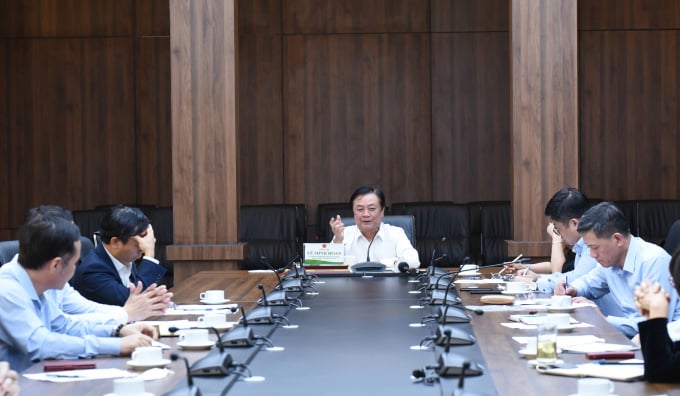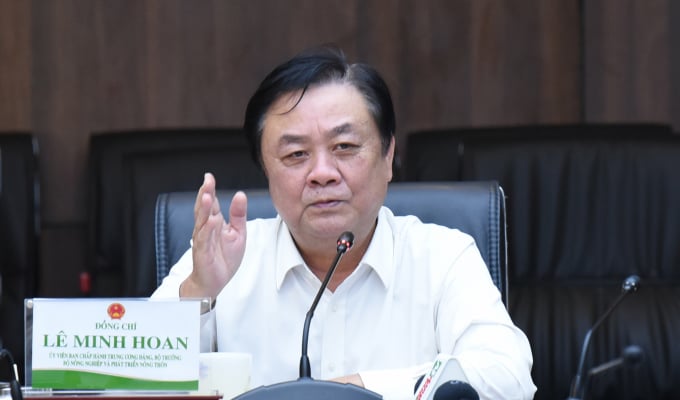November 26, 2025 | 10:41 GMT +7
November 26, 2025 | 10:41 GMT +7
Hotline: 0913.378.918
November 26, 2025 | 10:41 GMT +7
Hotline: 0913.378.918

Minister of Agriculture and Rural Development Le Minh Hoan chaired the meeting. Photo: Minh Phuc.
According to the Department of Livestock Production, in 2020, the whole country needs about 31.2 million tonnes of raw materials for animal feed. Only about 35% of them can be supplied domestically, the rest from imported sources.
Out of the total demand for refined feed ingredients, the energy-providing materials group (cereals: corn, bran, wheat, broken... and cassava roots) accounts for over 65% (equivalent to 21 million tonnes). The raw materials providing protein (vegetable protein, assorted oilseed meal, corn residue, DDGS; animal protein, meat and bone meal, fish meal...) accounted for over 27%, equivalent to 8.5 million tons.
Mr. Duong Tat Thang, Director of the Department of Livestock Production, said that the amount of domestically produced concentrate materials for livestock production is minimal.
By-products from the seafood processing industry, such as fish, shrimp, crab, snail, etc., are now mainly utilized as animal feed but only are produced based on simple technology such as drying and grinding in production (for example, fish meal, shellfish meal, shrimp meal, fish fat, fish oil...).
Vietnam's livestock and poultry slaughtering system is still small, so the by-products from this type of production have not been fully utilized for production and processing as animal feed. Moreover, by-products such as organs, the blood of cattle, and poultry from slaughterhouses in our country are still used as food for humans. In developed countries, these products are processed into meat and bone meal, blood powder, hydrolyzed feather powder... as animal feed.

Development of biomass maize varieties as forage for cattle raising. Photo: Ba Thang.
Mr. Nguyen Nhu Cuong, Director of the Department of Crop Production, said: There have been many types of research to select and develop many varieties of grass and forage plants such as terrestrial herbaceous plants mixed varieties. Flood-tolerant herbs and groups of legumes used for grazing cattle, multi-purpose plants.
Many models of growing livestock grass and biomass corn feed for dairy cows with high-economic efficiency of Moc Chau Dairy Cow Breeding Joint Stock Company, TH Group, and Vinamilk Joint Stock Company continue to be expanded in many locations.
However, due to the increasing number of dairy cows, the shortage of green forage is becoming more urgent, especially in the dry season. Therefore, to proactively source forage for livestock, companies have purchased thousands of tons of fresh corn plants each year to serve dairy cows.
In the long term, Mr. Nguyen Nhu Cuong said that it is necessary to plan the area for growing crops for animal feed associated with the planning for livestock development, closely and synchronously from the production stage to breeding techniques and farming techniques and processing.

According to Minister Le Minh Hoan, it is necessary to reduce the cost of input materials in livestock. Photo: Minh Phuc.
According to Mr. Pham Van Toan, Deputy Director of the Vietnam Academy of Agricultural Sciences, Vietnam has been forming insect rearing establishments from livestock waste and agricultural by-products and producing insect powder as a source of protein for livestock production on a small and spontaneous scale.
In 2019, the whole country exported over 291,000 tonnes of forage silage, earning over US$ 29 million in revenue, to 22 countries, of which mainly to Korea, the Netherlands, and Japan... with 13 types of goods such as silage corn stalks, silage bagasse, silage corn and soybeans, pineapple peels, silage bagasse...
Therefore, maize biomass is a plant with a high potential for development to provide forage for domestic livestock production and export, gradually replacing the current large amount of imported refined feed if there are appropriate production organization models and technology.
At a meeting to discuss solutions to reduce input costs for animal feed on April 19, the Minister of Agriculture and Rural Development Le Minh Hoan emphasized that feed costs account for about 60-70% of livestock production costs, so it is necessary to find ways to reduce the cost of input materials.
It is necessary to form and develop a market for agricultural by-products (for people who do not need to exchange and trade with those who have needs) and promote circular agriculture to take full advantage of the environment products reducing dependence on foreign supplies.
In the New Rural program, we need to encourage the establishment of cooperatives to produce and supply auxiliary products for the livestock and aquaculture sectors to take advantage of local agricultural by-products, thereby contributing to the creation of new occupations, and jobs creation, and income improvement for rural people.
Translated by Ha Phuc

(VAN) The Ministry of Agriculture and Environment must spearhead the construction of green governance, spanning decision-making processes and investment standards to policy evaluation mechanisms.

(VAN) The Agriculture and Environment sector of Khanh Hoa has achieved numerous milestones over the past 80 years, contributing significantly to the goal of establishing the province as a centrally governed city by 2030.

(VAN) Viet Nam is entering the pivotal period of 2025-2030, moving toward the formulation of the Remote Sensing Law, which will establish a legal foundation for the development of national digital data.

(VAN) The agricultural sector is finalizing the strategic framework for emission reduction, setting the goal of sharply cutting methane and 403.7 million tons of CO2 equivalent and moving toward Net Zero by 2050.
/2025/11/22/2236-1-153832_483.jpg)
(VAN) The National Marine Spatial Planning is opening up opportunities for sustainable blue sea development across 21 coastal localities.

(VAN) Viet Nam’s forestry sector is undergoing a comprehensive transformation, strengthening management, protection, and development efforts to maintain ecological security and drive green, sustainable growth.

(VAN) Viet Nam is accelerating efforts to digitize reservoir operations, from real-time data to hydraulic modelling.